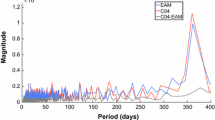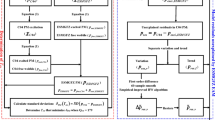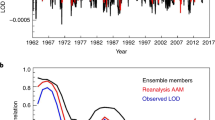Abstract
Real-time orbit determination and interplanetary navigation require accurate predictions of the orientation of the Earth in the celestial reference frame and in particular that for Universal Time UT1. Much of the UT1 variations over periods ranging from hours to a couple of years are due to the global atmospheric circulation. Therefore, the axial atmospheric angular momentum (AAM) forecast series may be used as a proxy index to predict UT1. Our approach taking advantage of this fact is based on an adaptive procedure. It involves incorporating integrations of AAM estimates into UT1 series. The procedure runs on a routine basis using AAM forecasts that are based on the two meteorological series, from the US National Centers for Environmental Prediction and the Japan Meteorological Agency. It is pertinent to test the prediction method for the period that includes the special CONT08 campaign over which we expect a significant improvement in UT1 accuracy. The studies we carried out were aimed both to compare atmospheric forecasts and analyses, as well as to compare the skills of the UT1 forecasts based on the method with atmospheric forecasts and that using current statistical processes, as applied to the C04 Earth orientation parameters series derived by the International Earth rotation and Reference Systems service (IERS). Here we neglect the oceanic sub-diurnal and diurnal variations, as these signals are expected to be smaller than the UT1-equivalent of 100 μs, when averaged over a few days. The prediction performances for a 2-day forecast are similar, but at a forecast horizon of a week, the AAM-based forecast is roughly twice as skillful as the statistically based one.
Similar content being viewed by others
References
Abarca del Rio R, Gambis D, Salstein DA (2000) Interannual variability in the Earth rotation and the atmospheric angular momentum. Ann Geophys 18(3): 347–364
Barnes RTH, Hide R, White AA, Wilson CA (1983) Atmospheric angular momentum fluctuations, length-of-day changes and polar motion. Proc R Soc Lond A 387: 31–73
Biancale R, Gambis D, Richard JY (2011) Why combining at the Observation Level? Submitted to REFAG symposium. IAG series
Bizouard C, Gambis D (2009) The combined solution C04 for Earth Orientation Parameters. recent improvements. In: Drewes H (ed) Series International Association of Geodesy Symposia, vol 134. Springer, Berlin, pp 265–270
Bryan JG, Enger I (2010) Use of probability forecasts to maximize various skill scores. J Appl Meteorol 6(5): 762–769
Chao BF, Yan H (2010) Relation between length-of-day variation and angular momentum of geophysical fluids. J Geophys Res 115: B10417. doi:10.1029/2009JB007024
Chao BF, Dehant V, Gross RS, Ray DD, Salstein DA, Watkins MM, Wilson CR (2000) Space geodesy monitors mass transports in global geophysical fluids, EOS. Trans Am Geophys Union 81: 247–250
Dickman SR (1988) Theoretical investigation of the oceanic inverted barometer response. J Geophys Res 93: 14941–14946
Dill R, Dobslaw H (2010) Short-term polar motion forecasts from Earth system modeling data. J Geodesy 84(9): 529–536
Feissel M, Gambis D, Vesperini T (1988) Predicting weeks to months variations of the earth rotation parameters. In: Babcock AK, Wilkins GA (eds) Reidel, pp 269–273
Gambis D (1990) Universal time prediction using both geodetic and atmospheric angular momentum data. Springer, New York Publishers, pp 35–39
Gambis D (2004) Monitoring Earth orientation at the IERS using space-geodetic observations. J Geodesy 78: 295–303
Gambis D, Richard JY, Salstein DA (2008) Use of atmospheric angular momentum forecasts for UT1 prediction. In: Capitaine N (ed) Proc. Journées Systèmes de Référence 2007, pp 210–212
Gambis D, Bizouard C (2009) Monitoring UT1 using VLBI and GPS estimates. In: Bourda G, Charlot P, Collioud A (eds) Proceedings of 19th European VLBI for Geodesy and Astrometry and EVGA, p 107
Gambis D, Biancale R, Carlucci T, Lemoine JM, Marty JC, Bourda G, Charlot P, Loyer S, Lalanne L, Soudarin L (2009) Combination of Earth orientation parameters and terrestrial frame at the observation level. In: Drewes H (ed) Springer series, Series International Association of Geodesy Symposia, vol 134, pp 3–9
Heidke P (1926) Berechnung des Erfolges und der Güte der Windstärkevorhersagen im Sturmwarnungdienst. Calculation of the success and goodness of strong wind forecasts in the storm warning service. Geogr Ann Stockholm 8: 301–349
Johnson TJ, Luzum BJ, Ray JR (2005) Improved Near-term UT1R predictions using forecasts of atmospheric angular momentum. J Geodyn 39(3): 209–221
Kalarus M, Schuh H, Kosek W, Akyilmaz O, Bizouard Ch, Gambis D, Gross R, Jovanovic B, Kumakshev S, Kutterer H, Ma L, Mendes Cerveira PJ, Pasynok S, Zotov L (2010) Achievements of the Earth orientation parameters prediction comparison campaign, JoG accepted
Kalnay E, Jenne R (1991) Summary, of the NMC/NCAR reanalysis workshop of April 1991. Bull Am Meteorol Soc 72: 1897–1904
Kanamitsu M (1989) Description of the NMC global data assimilation and forecast system. Weather Forecast 4: 335–342
Luzum B, Nothnagel A (2010) Improved UT1 predictions through low-latency VLBI observations. J Geodesy 84(6): 399–402
Murphy AH (1993) What is a good forecast? An essay on the nature of goodness in weather forecasting. Weather Forecast 8: 281–293
Niedzielski T, Kosek W (2008) Prediction of UT1-UTC, LOD and AAM χ3 by combination of least-squares and multivariate stochastic methods. J Geodesy 82(2): 83–92
Ponte RM, Gaspar P (1999) Regional analysis of the inverted barometer effect over the global ocean using Topex/Poseidon data and model results. J Geophys Res 104(c7): 15587–15601
Ponte RM, Salstein DA, Rosen RD (1991) Sea level response to pressure forcing in a barotropic numerical model. J Phys Oceanogr 21: 1043–1057
Ponte RM, Stammer D, Marshall J (1998) Oceanic signals in observed motions of the Earth’s pole of rotation. Nature 391: 476–479
Rosen RD, Salstein DA (1983) Variations in atmospheric angular momentum on global and regional scales and the length of day. J Geophys Res 88: 5451–5470
Rosen RD, Salstein DA, Nehrkorn T (1991) Prediction of zonal wind and angular momentum by the NMC medium-range model during 1985–89. Month Weather Rev 119: 208–217
Salstein DA, Kann DM, Miller AJ, Rosen RD (1993) The Sub-Bureau for atmospheric angular momentum of the International Earth Rotation Service (IERS): a meteorological data center with geodetic applications. Bull Am Meteorol Soc 74(1)
Salstein DA (2003) The GGFC Special Bureau for the Atmosphere of the International Earth Rotation and Reference Systems Service. In: Richter B, Schwegmann W, Dick WR (eds) Proceedings of the IERS Workshop on Combination Research and Global Geophysical Fluids. IERS Technical Note. No. 30, Frankfurt am Main, Germany. Verlag des Bundesamtes für Kartographie und Geodäsie, pp 121–124. ISBN 3-89888-877-0
Wooden W, Johnson T, Kammeyer P, Carter M, Myers A (2005) Determination and prediction of UT1 at the IERS Rapid Service/Prediction Center. Journees Systemes de Reference Spatio-Temporels 2004: 260–263
World Meteorological Organization (2007) Outline of the operational numerical weather prediction at the Japan Meteorological Agency. WMO Technical Progress Report on the Global Data-Processing and Forecasting System and Numerical Weather Prediction, Geneva
Wunsch C, Stammer D (1997) Atmospheric loading and the oceanic inverted barometer effect. Rev Geophys 35(1): 79–107. doi:10.1029/96RG03037
Zhou YH, Salstein DA, Chen JL (2006) Revised atmospheric excitation function series related to Earth’s variable rotation under consideration of surface topography. J Geophys Res 111, No. D12, D12108. doi:10.1029/2005JD006608
Author information
Authors and Affiliations
Corresponding author
Rights and permissions
About this article
Cite this article
Gambis, D., Salstein, D. & Lambert, S. Use of atmospheric angular momentum forecasts for UT1 predictions: analyses over CONT08. J Geod 85, 435–441 (2011). https://doi.org/10.1007/s00190-011-0479-6
Received:
Accepted:
Published:
Issue Date:
DOI: https://doi.org/10.1007/s00190-011-0479-6




